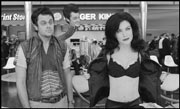Remember The Black Stallion? The gorgeously shot tale of a 10-year-old boy and his horse played Seattle for almost a year back in ’79. The Stunt Man? We made that film in 1980 with another record-breaking engagement. In ’84, Amadeus began a run exceeding 12 months. Once, Seattle filmgoers could feel a certain regional pride in nurturing such deserving titles; we were one of the few true outposts of cinema sophistication west of the Hudson River.
Is that still true? With our SIFF-inflated pride and art-house institutions like the Harvard Exit, we like to think we’re a cut above the multiplex country. Meanwhile, Hollywood is booming this summer with Spider-Man and Attack of the Clones; the national box office has surged 20 percent over last year. So are we just lapping up those same blockbusters with everyone else, or are we still special? Can we still sustain long-running films against the commercial tide?
Huge market forces are working against us. These days, studio economics are completely tied to the weekly event-movie cycle (next up: Wednesday’s Men in Black II). Supported by massive national advertising campaigns, blockbusters typically open on 3,000-plus screens the first weekend. You’re compelled to see the movie just to figure out what Entertainment Weekly, Entertainment Tonight, and David Letterman are talking about.
Then the juggernauts usually do a quick fade. A film like MiBII may debut on 24 Seattle screens (showing every 30 minutes at the same multiplex). The second weekend, it’s down to 12; the third, six; and on the fourth, it’s playing discount shows at the Admiral.
Studios have little incentive to let movies linger for months because they make most of their money up front, owing to advantageous revenue-sharing terms. Later on, they cede more to theater operators. (The shift to a quick-churning, front-loaded movie economy is one reason most national exhibitors have recently gone through bankruptcy.)
“The entire climate of the movie business has changed,” explains veteran booker Ruth Hayler of the Landmark/Seven Gables chain, which emerged from Chapter 11 bankruptcy last year. Even in her world of specialty films, “There’s such pressure to take things off,” she says. Each Friday brings a slew of new titles clamoring for screens. Among them are dogs whose release mainly serves as advertising for the imminent DVD (Exhibit A: Cherish, the home-arrest comedy with Robin Tunney that died a week after its June 21 debut). As a result, good titles invariably get lost in the chaos—for example, the worthy New Zealand coming-of-age flick Rain, which got yanked only three weeks after its May 16 opening.
There have been some profitable exceptions for Landmark, like David Lynch’s Mulholland Drive, which lasted almost seven months after its October ’01 debut; Am鬩e, at eight months and counting; and Y Tu Mam᠔ambi鮼/I>, here since April 5. The sleeper surprise My Big Fat Greek Wedding has actually picked up steam after its April 19 opening, says Hayler.
Still, those are also national success stories. Are there particular local favorites that Seattle has championed with its distinctive tastes? Several, according to Hayler, who cites Ghost World, Waking Life, Metropolis, and Princess Mononoke. Their success likely stems from Seattle’s avid culture of comic book and graphic novel readers; manga is spoken here—particularly in the U District, which Landmark dominates with the Metro, Neptune, Varsity, and Seven Gables.
Other Seattle-only exceptions? Hayler lists Monsoon Wedding (four months), Italian for Beginners (three months), Gosford Park (five months), and Iris (two months).
Sherman Alexie’s The Business of Fancydancing was held five weeks after its initial weeklong May engagement, Hayler recalls, drawing not only traditional art-house viewers but also a remarkable concentration of Indian filmgoers. (It’s no Stunt Man, but Seattle did its best to put Fancydancing on the map.)
Also, “outdoor scenery does well in Seattle,” Hayler laughs. The evidence? The Tibetan trekker’s fave Himalaya, the Shackleton doc The Endurance, and the new Inuit epic The Fast Runner—which seems poised for a marathon run.
Then there are the mysteries, she admits. The Royal Tenenbaums did particularly well here. So did O Brother, Where Art Thou?, unlike the Coen brothers’ The Man Who Wasn’t There (which I’d argue is a sign of sound local judgment). Hollywood Ending died an unusually fast death (again, good riddance). As for Time Out, the best film I’ve seen this year, it underperformed compared to other markets, with only a three-week run after April 26, but perhaps it was too depressing and too French even for Seattle.
Of course, Time Out will be on DVD eventually. So why should anyone care how long it plays in theaters? Does it really matter if people are lined up in the rain outside the Harvard Exit to see the next effort by Jean-Luc Godard or Tom Tykwer or Steven Soderbergh?
Yes: It matters to Capitol Hill merchants; it matters to Landmark (which recently lost the lease on its Broadway Market Cinemas); it matters to the overall cultural health of the city. (And, dammit, it matters to me; I need the job!) Curling up on the couch at home to watch a video is fine, but the movies are a fundamentally popular, communal medium: We see them together.
Hayler lauds the good old days (before video), when the voice of the individual critic—in particular The Seattle Times‘ John Hartl—wasn’t drowned out by marketing hype and two-page movie ads laden with pull quotes by effusive hacks. Back then, the trinity of critic, audience, and exhibitor could make a movie. Today, it’s the marketers. And they’ve always got something new to sell ya.








